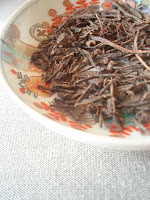
I’m a lot wondering since when early-summer gets full of festivals in Tokyo. Foreign cultural events have gradually been tempting the young lads, as Jamaica, Thai and Laos, these three festivals made a consecutive success at Yoyogi Park, followed by one of the most iconic Shinto festivals called “Sanja Matsuri” in downtown Asakusa. If you want endless cheers with decent beer, just stop by German-imported “Oktberfest” currently ongoing in the other urban oasis, Hibiya Park and more to come.
This time of year is hearty enough to offer sunshine days which are perfect for singing, dancing, eating and drinking outside. Perhaps, we need some alfresco rituals to expel the rainy blues on its way. Festival is better than the songs of birds in Japan? At least, Tokyo is like so.
Well, cooking inside... This recipe has been a regular dish of my family since I happened to find the original in “Lee” a Japanese women’s lifestyle magazine almost ten years ago. “Tsukune” is basically referred to as chicken “balls” in Japanese yakitori cuisine, however, a little change in shape and flavour gives more elegant impact at the table, especially when you have dinner guests around. Your mouth will be delighted with the contrasting texture between the tender meat and the crunchy rotus root. The recipe is also a good specimen to showcase that Japanese “kombu” (kelp) is usable not only to accompany boiled rice, but to season in cooking. Sweet, salty and something intensified in one dish... The taste is 100% guaranteed!
PAN-FRIED CHICKEN TSUKUNE
* To make 9 pieces
300g minced chicken
100g lotus root (available in an Asian grocery)
30g shredded shiofuki-kombu (salty kelp. Available in a Japanese grocery)
1-2 shiitake mushrooms, finely chopped
1 tbsp sake (or dry sherry)
1 tsp soy sauce
2 tsp sesame oil
25cm x 25cm non-stick baking paper
1. Peel the rotus root and soak in lightly-vinegered water for 10 minutes to stop colouring. Cut into a couple of chunks, and bash with a rolling pin in a freezer bag until they are teaspoonful bits. Some are totally crumbled, but it’s fine.
2. Using your hands, mix the minced chicken, root, shiitake, soy and sake together in a bowl until well-combined. Add the shiofuki-kombu, mix gently this time and leave for 10 minutes until the flavour is settled.

3. Shape the mixture into a large single square on baking paper to a thickness of 1.5cm. Love this labour...
4. Heat the sesame oil in a frying pan over a medium heat. Carefully, lay the mixture on the pan, papered side up so that the baking paper can work like a lid to steam the whole mixture. In 5 minutes, remove the paper and turn the mixture over to cook until browned and just cooked through.
5. Remve it from the pan and cut into 9 squares. Serve hot, warm or even cold, so ideal for bento boxed lunch!
Tips:
1. In the shaping process of #3, don’t make it thinner to avoid cracks when cooked.
2. Help yourself to season with shichimi togarashi at the table if you prefer a spicy kick.

FYI, “kombu” (kelp seaweed), dried or fresh, has been consumed daily in various cookery forms such as dashi (broth), nimono (stewed dish) and tsukemono (pickles), but my favourite is “shiofuki-kombu” (salty kelp) on the photo. It’s a sort of semi-dried “tsukudani”, which is kelp, vegetable, fish or shellfish boiled down in soy sauce for a long time. If you see the whole surface of shiofuki-kombu is covered with salt-like fine powder, that’s exactly what we mean by “umami”, the Japanese sea-born savouriness. Ah, one more thing to share: nibble shiofuki-kombu on its own when sipping sake. Tasty, plus, it’s said amino acids in the kelp break down the alcohol component. Delicious science.
Japanese even has a fusion pasta recipe with shiofuki-kombu to toss. Hey, you don’t have to buy “Taste No 5”!!






